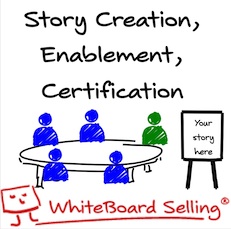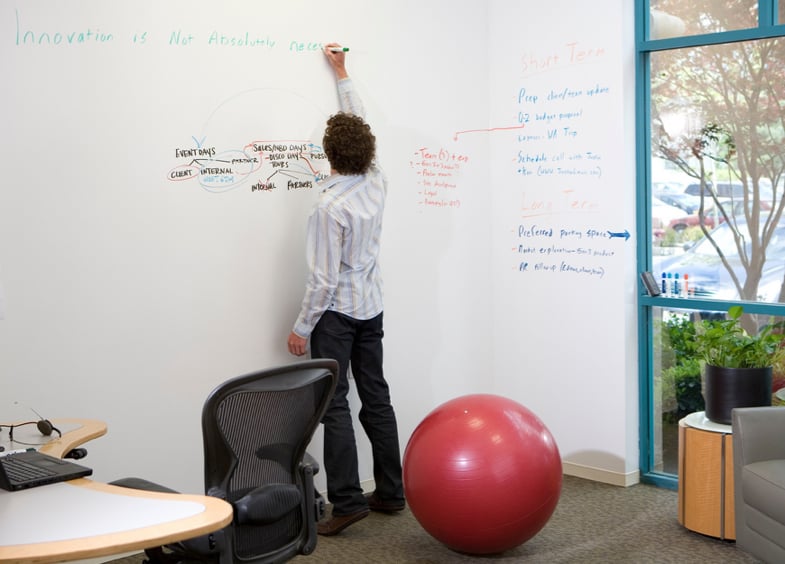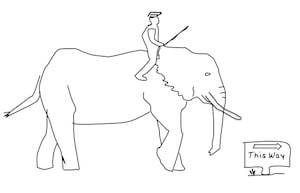Sounds like a line from a familiar TV show, except it would be "put the gun down and step away from the ....."
The best advice I can give to sales professionals whether starting out or with 20 years experience, is to put the clicker down and step away from the PowerPoint projector.

There may be a time toward the end of the sales cycle when the buyer actually wants to see a presentation of your proposed solution... then it's OK to present. If you want to use Powerpoint, then please use the resources for creating engaging PowerPoint presentations....otherwise I recommend that you learn to use a whiteboard to tell your story.
Whiteboarding is most powerful when used for discovery, it's a visually engaging, collaborative exercise. Whiteboarding when done correctly, provides wonderful opportunities to engage buyers in conversation at any point in the sales cycle.
In addition, it helps you both visually capture issues and details and drill down on problems and priorities that may otherwise be lost. Capturing and documenting next steps in the meeting also provides great visual commitment to joint action.
Many inexperienced salespeople are "spilling their proverbial candy in the lobby" by using the Present>Qualify>Close sequence....although this is less of a problem than it was in the pre-Interent era, now that product information, proof points and relevant feedback from actual users are a couple of keystrokes away....(sales people get less opportunity to make this mistake).
A more typical path for B2B sales is Qualify>Present>Close.
Sandler suggests Qualify>Close>Present and I like this idea a lot.
By asking a couple of simple, but important questions prior to agreeing to do a presentation, salespeople can gain a degree of control and decide if it makes sense to do a presentation (same goes for a demonstration).
If the answer to this is fluffy or lacks a commitment to entering into a sequence of events that will result in a sale, then don't present. Find out what you need to do and what the buyer wants to see in order to make a decision before you present...it will save you time and produce better outcomes from your presentations.
The best advice I can give to sales professionals whether starting out or with 20 years experience, is to put the clicker down and step away from the PowerPoint projector.

There may be a time toward the end of the sales cycle when the buyer actually wants to see a presentation of your proposed solution... then it's OK to present. If you want to use Powerpoint, then please use the resources for creating engaging PowerPoint presentations....otherwise I recommend that you learn to use a whiteboard to tell your story.
Typical Sales Presentations are 95% about you and your stuff, not issues central to the Buyer
How much do you learn about the buyers situation and what they care about when you are presenting? A typical sales presentation is a 95% one-way conversation and its typically all about you...not the issues central to the buyer.Whiteboarding is most powerful when used for discovery, it's a visually engaging, collaborative exercise. Whiteboarding when done correctly, provides wonderful opportunities to engage buyers in conversation at any point in the sales cycle.
In addition, it helps you both visually capture issues and details and drill down on problems and priorities that may otherwise be lost. Capturing and documenting next steps in the meeting also provides great visual commitment to joint action.
Don't present until you have qualified the opportunity and figured out a solution.
One of the most useful things I learned from a Sandler training course nearly 10 years ago was in changing the way salespeople engage a buyer.Many inexperienced salespeople are "spilling their proverbial candy in the lobby" by using the Present>Qualify>Close sequence....although this is less of a problem than it was in the pre-Interent era, now that product information, proof points and relevant feedback from actual users are a couple of keystrokes away....(sales people get less opportunity to make this mistake).
A more typical path for B2B sales is Qualify>Present>Close.
Sandler suggests Qualify>Close>Present and I like this idea a lot.
By asking a couple of simple, but important questions prior to agreeing to do a presentation, salespeople can gain a degree of control and decide if it makes sense to do a presentation (same goes for a demonstration).
Who else other than you...?
"Who else other than you will be involved in the decision process ...does it make sense to invite them to the presentation/demonstration?" This will save you time and should produce outcomes where a decision is more likely. Follow this with....What will happen if....?
"What will happen if we complete the presentation/demonstration and you really like what you see?"If the answer to this is fluffy or lacks a commitment to entering into a sequence of events that will result in a sale, then don't present. Find out what you need to do and what the buyer wants to see in order to make a decision before you present...it will save you time and produce better outcomes from your presentations.




